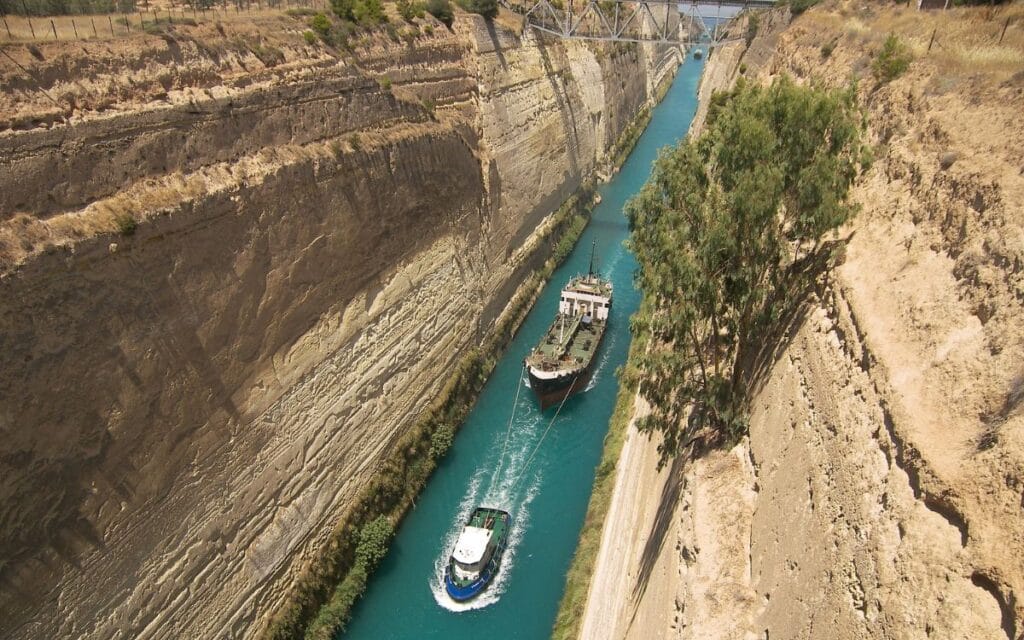Corinth Canal
Corinth Canal

The Corinth Canal was conceived in antiquity, but its construction was delayed for centuries due to a variety of obstacles, including political and technical challenges. The idea of connecting the two seas through the Isthmus dates back to the 7th century BCE, when the Greek tyrant Periander first proposed the idea. However, it was not until the late 19th century that the canal was finally completed, under the direction of French engineers and the support of the Greek government.
The canal’s construction was a monumental task. It required the excavation of solid rock and the creation of a narrow, deep passage that would allow ships to bypass the lengthy and treacherous trip around the Peloponnese Peninsula. Completed in 1893, the Corinth Canal dramatically reduced the time and distance needed for maritime trade between the Aegean and Ionian Seas, providing ships with a shortcut that avoided the long, dangerous journey around the southern tip of the Peloponnese.
The Corinth Canal has a unique and narrow structure, with a width that varies from 21 to 25 meters (69 to 82 feet) and a depth of about 8 meters (26 feet). While the canal is too narrow for modern-day large vessels, it remains an essential route for smaller ships, yachts, and tourist boats. The dramatic cliffs on either side of the canal rise up to 90 meters (295 feet), creating a stunning and imposing natural backdrop that adds to the canal’s beauty and historical significance.
Visitors to the Corinth Canal can experience its grandeur from several viewpoints, including a bridge that spans the canal, offering a breathtaking view of the narrow waterway below. There are also several observation points where tourists can watch boats passing through the canal, and many choose to take a boat tour to appreciate the scale of the canal from the water. The canal is also a popular location for bungee jumping, with thrill-seekers leaping from the bridge above, offering a unique and adrenaline-pumping experience.
The canal’s impact on the region goes beyond its role as a maritime shortcut. It has played a vital role in shaping the economy and infrastructure of Corinth and the surrounding areas. The canal has been used for commercial purposes for over a century, and it continues to serve as an important route for cargo and passenger ships, particularly those traveling between Greece and the Adriatic.
In addition to its practical uses, the Corinth Canal is also a cultural and historical landmark. It stands as a symbol of human ingenuity and determination, as it represents the culmination of centuries of vision and effort. The canal’s completion helped to usher in a new era of transportation and trade in the region, making it one of the most significant engineering achievements in Greek history.
For those interested in exploring the canal’s rich history, the nearby town of Corinth offers a wealth of archaeological sites and ancient ruins. The ancient city of Corinth, once a powerful and prosperous city-state, is home to the Temple of Apollo, the ancient Agora, and the Acrocorinth, the city’s acropolis. The Corinth Canal is located just a short drive from these ruins, making it an ideal destination for travelers interested in both modern engineering and ancient history.
In conclusion, the Corinth Canal is a remarkable testament to human engineering and innovation. Its historical importance, stunning views, and ongoing relevance make it one of Greece’s most fascinating landmarks. Whether you’re marveling at the sheer scale of the canal from the bridge, taking a boat ride through its waters, or exploring the nearby archaeological sites, the Corinth Canal offers a unique and unforgettable experience for visitors of all interests.

